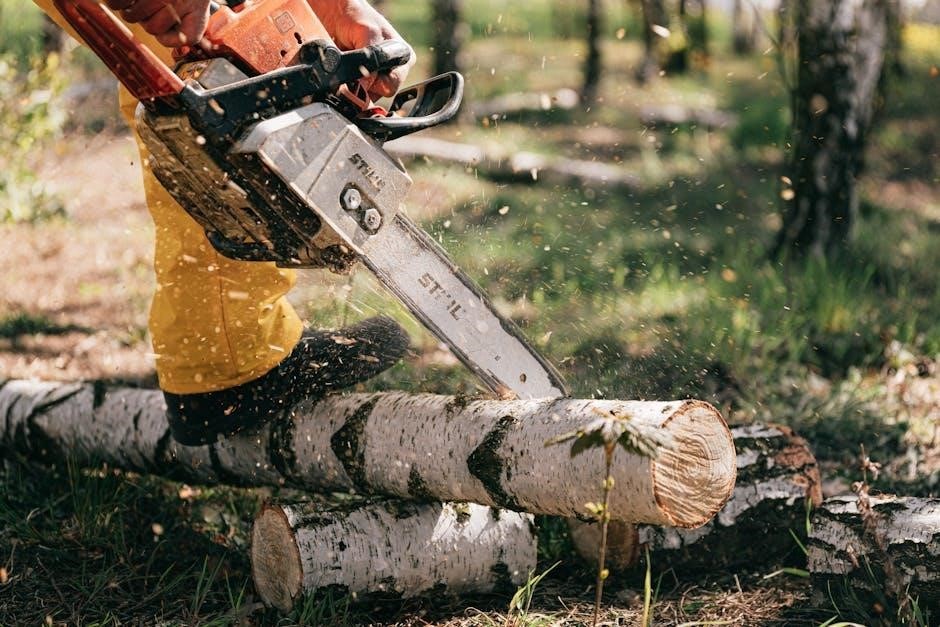
Understanding Chainsaw Chain Specifications
Chainsaw chain specifications‚ including gauge‚ pitch‚ and chain type‚ are critical for selecting the right files and guides. Gauge refers to the chain’s thickness‚ pitch is the distance between links‚ and chain type determines cutting style. These details ensure proper tool compatibility and optimal performance‚ preventing damage and ensuring safety.
Importance of Gauge‚ Pitch‚ and Chain Type
Gauge‚ pitch‚ and chain type are essential for selecting the right files and guides. Gauge refers to the chain’s thickness‚ ensuring compatibility with the bar and optimal cutting performance. Pitch‚ the distance between links‚ determines the size of the file needed for sharpening. Chain type varies by cutting style‚ such as ripping or cross-cutting‚ affecting the sharpening angle and technique. Understanding these specifications ensures proper tool selection‚ prevents damage‚ and maintains safety. Misalignment can lead to inefficient cutting‚ premature wear‚ or even chainsaw malfunction‚ making accurate identification critical for effective sharpening and long-term chain durability.

Safety Tips for Using Chainsaw Files and Guides
Always wear gloves and safety glasses to protect against metal shavings. Work in a well-lit area and keep fingers clear of the chain during sharpening to avoid accidents.
Essential Precautions: Gloves‚ Safety Glasses‚ and Work Environment
Always wear gloves to ensure a firm grip and protect hands from cuts. Safety glasses shield eyes from flying metal shavings. Work in a well-lit‚ clutter-free area for clear visibility. Keep fingers away from the chain during sharpening to avoid injuries. A stable work surface prevents accidents‚ while proper lighting ensures precise filing. Maintaining these precautions minimizes risks and ensures safe‚ effective sharpening of your chainsaw chain.

Choosing the Right Chainsaw File and Guide
Selecting the correct chainsaw file and guide involves matching your chain’s gauge‚ pitch‚ and type. Deluxe or budget options vary in features‚ but both ensure precise sharpening. Reliable brands like Oregon and Stihl offer durable‚ high-quality tools designed for specific chain types‚ ensuring optimal performance and safety. Always consider your chain’s specifications to make the best choice for effective sharpening and extended chain life.
Step-by-Step Guide to Finding the Correct File Size
To find the correct file size for your chainsaw‚ start by measuring the chain’s pitch. Locate three rivets on the chain and measure the distance between them‚ then divide by two. This gives the pitch size‚ which determines the file size. Use a file size chart to match the pitch with the correct diameter. For example‚ a 0.325″ pitch chain typically requires a 3/16″ file‚ while 3/8″ pitch chains use 7/32″ files. Ensure compatibility with your chain type (standard‚ semi-chisel‚ or full chisel) and always use the guide to maintain the correct angle for precise sharpening.

Types of Chainsaw File Guides
Chainsaw file guides include deluxe and budget options‚ offering features like precision alignment‚ combination tools‚ and portability. Deluxe guides often have built-in depth gauges‚ while budget guides provide essential functionality at a lower cost. Both types ensure accurate sharpening‚ improving chain performance and safety.
Deluxe vs. Budget Options: Features and Benefits
Deluxe chainsaw file guides offer advanced features like built-in depth gauges‚ precision alignment‚ and combination tools‚ ensuring professional-grade sharpening. They often include multiple files and ergonomic handles‚ enhancing comfort and accuracy. Budget options‚ while more basic‚ provide essential functionality at a lower cost‚ making them ideal for occasional use. Both types improve sharpening consistency‚ but deluxe models offer superior durability and versatility. Choosing between them depends on usage frequency and personal preference‚ ensuring optimal chain performance and safety regardless of the option selected.

How to Sharpen a Chainsaw Chain
Secure the chainsaw‚ position the guide‚ and use a round file to sharpen cutters at the correct angle. Apply consistent forward pressure‚ ensuring even sharpening for optimal performance.
Step-by-Step Instructions for Using a Round File and Guide
Secure the Chainsaw: Clamp the chainsaw bar in a vise to keep it stable during sharpening.
Position the Guide: Attach the file guide to the chainsaw bar‚ aligning it with the chain’s teeth.
Insert the Round File: Place the round file into the guide‚ ensuring it fits snugly.
Sharpen Each Tooth: Starting from one end‚ push the file forward across each tooth at the recommended angle (usually 30-35 degrees).
Maintain Even Pressure: Apply consistent‚ moderate pressure to avoid uneven sharpening.
Check Progress: After a few strokes‚ inspect the tooth for sharpness and adjust the angle if necessary.
Repeat for All Teeth: Continue sharpening each tooth‚ moving along the chain to ensure uniform sharpness.
Finish and Clean Up: Remove the guide and file‚ then clean any metal shavings from the chain.
This method ensures a sharp‚ balanced chain for optimal performance and safety.
Role of a Flat File and Depth Gauge in the Sharpening Process
A flat file is used to adjust the depth gauges on the chainsaw chain‚ ensuring proper cutting depth. Depth gauges control how deep the chain cuts into wood; if they are too high‚ the chain won’t cut efficiently‚ and if too low‚ it may damage the bar or chain. The depth gauge tool measures and resets these gauges to the recommended height. After sharpening with a round file‚ use the flat file to lightly lower the gauges‚ maintaining optimal cutting performance. This step is crucial for safety and effectiveness‚ ensuring the chain operates within manufacturer specifications.

Maintaining Your Chainsaw Chain
Regularly clean the chain to remove debris and rust‚ ensuring optimal performance. Store it in a dry place or with a protective covering to prevent corrosion. Always check for wear and tear‚ filing as needed to maintain sharpness and efficiency.
Cleaning and Storing the Chain for Optimal Performance
Regular cleaning is essential to maintain your chainsaw chain’s efficiency. Use a stiff brush to remove dirt and debris‚ then clean with mild detergent and water. Dry thoroughly to prevent rust. For storage‚ keep the chain in a dry place‚ away from direct sunlight. Apply a rust-inhibiting spray for added protection. Store the chain separately from the bar to avoid damage. Proper cleaning and storage ensure the chain remains sharp‚ reduces wear‚ and extends its lifespan. Always inspect the chain before use to ensure it’s clean‚ dry‚ and free of corrosion for optimal performance.

Top Chainsaw File and Guide Products
Top-rated options include Oregon’s 25894 File and Guide Set‚ Stihl’s 2-in-1 Filing Guide‚ and Katzco’s Chainsaw Sharpener Kit. These products offer durability‚ precision‚ and ease of use‚ ensuring optimal chain maintenance and performance for both professionals and hobbyists.
Recommended Kits: Oregon‚ Stihl‚ and Katzco Options
Oregon’s 25894 File and Guide Set is a budget-friendly option with a round file‚ guide‚ and wooden handle‚ ideal for quick sharpening. Stihl’s 2-in-1 Filing Guide includes a built-in depth gauge and multiple files‚ offering precision for professionals. Katzco’s Chainsaw Sharpener Kit provides versatility with 3/16‚ 5/32‚ and 7/32-inch files‚ a depth gauge‚ and a pouch for organization. These kits are designed for durability‚ ease of use‚ and optimal chain maintenance‚ catering to both professionals and DIY enthusiasts. They ensure sharp‚ efficient cuts and extend chain life‚ making them essential for any chainsaw user.

Common Mistakes to Avoid
Common errors include incorrect filing angles‚ over-sharpening‚ and inconsistent pressure. These mistakes can lead to uneven teeth‚ reduced chain life‚ and decreased cutting efficiency. Avoid them for better performance.

Incorrect Filing Angles and Over-Sharpening
Incorrect filing angles and over-sharpening are common mistakes that reduce chain performance. Filing at the wrong angle can lead to uneven cutting and premature wear. Over-sharpening weakens the chain‚ causing breakage. Always use a guide to maintain the correct angle and avoid excessive filing. Depth gauges should also be checked to ensure proper cutter height. Neglecting these steps can result in poor cutting efficiency and safety hazards. Regularly inspect and adjust your technique to prevent these issues and extend chain life. Proper filing practices are essential for optimal chainsaw performance and user safety.

Portable Sharpening Solutions
Portable chainsaw sharpening kits offer convenience for field use. Compact designs include round files‚ guides‚ and handles‚ ensuring sharp chains anywhere. Universal options like Oregon’s kit provide efficiency and portability.
Universal Chainsaw Sharpening Kits for Field Use
Universal chainsaw sharpening kits are designed for portability and versatility‚ making them ideal for field use. These kits typically include round files‚ flat files‚ and a guide to ensure precise sharpening. Compact and lightweight‚ they are easy to carry in a toolbox or backpack. Many kits‚ like Oregon’s universal sharpening set‚ cater to various chain pitches‚ such as .325” and 3/8”‚ ensuring compatibility with most chainsaws. The inclusion of a handle and depth gauge adds convenience‚ allowing users to maintain their chain’s performance on the go. These kits are perfect for outdoor enthusiasts and professionals needing quick‚ efficient sharpening solutions.